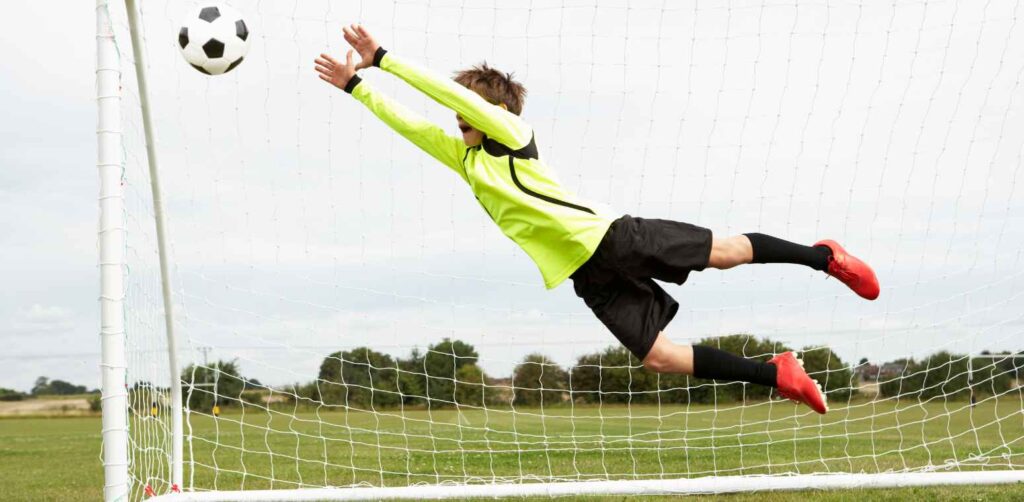1on1 football cambridge, Football Tutors Cambridge, Learn Football, Learn Football Cambridge
Goalkeeper’s Positioning in and out of Possession
Understanding how to position yourself as a goalkeeper is vital for improving performance in both training and match situations. A goalkeeper must know when to close down an attacker and when to stay back and protect the goal. This balance requires good awareness of space, correct body posture, reading the striker’s angle, and making effective decisions under pressure.
In and out of possession, positioning makes the difference between being exposed and controlling the game. The following session explores practical drills to develop decision-making, posture, and confidence in one-on-one situations.
Session Overview
The session is structured into five progressive parts, each focusing on different aspects of goalkeeper’s positioning in and out of possession.
- Part 1: 2v2 small-sided game – defending the space
- Part 2: In possession – ball rotation in a diamond
- Part 3: 1v1 scenarios – leg and footwork
- Part 4: 1v1 – closing down shooting angles
- Part 5: 1v1 – balls through and over from distance
Key Coaching Principles
Several principles guide these drills:
- The 3-metre rule: helps goalkeepers recognise when to challenge for the ball and when to hold their position.
- Body posture: a low stance with lowered hands when close to attackers; a tall, upright stance for longer shots.
- Positioning: always consider the distance to the attacker and the angle of the goal.
- Decision triggers: knowing when to step out, when to stay high, and when to retreat.
Drill Details and Organisation
Drill 1: 2v2 Small-Sided Game – Defending the Space
Two attacking goalkeepers must run the ball to a line, score in mini goals, or shoot at mannequins. The defending keepers focus on decision-making and awareness of when to close down or hold position.
- Organisation: Mark out a small pitch with mini goals or mannequins. Two attackers and two defenders rotate roles.
- Objectives: Improve positioning in 1v1s, awareness of space, and body posture under pressure.
Drill 2: Ball Rotation in a Diamond
Four goalkeepers rotate the ball in a diamond formation, replicating build-up play with centre-backs.
- Organisation: Set up four cones in a diamond. Two keepers act as centre-backs, two rotate between the cones.
- Objectives: Develop passing angles, support positions, and footwork. Train keepers to reposition when possession is lost and prepare for shots in transition.
Drill 3: 1v1 Scenarios – Leg and Footwork
The coach sets up strikers for direct attacks. The goalkeeper must adjust their body to block, smother, or save.
- Organisation: Place a coach behind mannequins or cones to feed balls to strikers. Strikers aim for quick finishes.
- Objectives: Build reactions, adjust posture depending on attacker’s angle, and handle rebounds.
Drill 4: Closing Down Shooting Angles
The goalkeeper in possession plays a goal kick, receives the return, and then sets up strikers making runs. The opposite goalkeeper must close down and block.
- Organisation: Half-pitch setup with mannequins and strikers. Keepers alternate between distribution and defending roles.
- Objectives: Improve judgement on when to leave the line, practise closing space quickly, and read attacking runs.
Drill 5: Through and Over Balls from Distance
The coach delivers through-balls or lofted passes beyond mannequins for strikers to chase. The goalkeeper decides whether to stay high or retreat.
- Organisation: Mark mannequins as defenders on the halfway line. Coach plays balls into attacking space.
- Objectives: Encourage quick decisions on positioning, improve handling of long passes, and prepare for one-on-one finishes.
Coaching Points and Tips
- Adjust posture based on distance to attacker.
- Keep feet active and spaced correctly for quick reactions.
- Read cues from the striker’s body language and movement.
- Stay composed under pressure to make better decisions.
- Practise reaction saves, smothering techniques, and blocking angles.
- Recognise when to hold ground and when to challenge directly.
Variations and Progressions
- Introduce time limits such as 10-second attacks.
- Add pressing players to increase pressure.
- Change pitch size or mannequin placement to alter scenarios.
- Restrict rules, e.g. attackers only allowed one touch.
These variations keep training challenging and realistic, preparing goalkeepers for match conditions.
Wrap Up / Session Summary
Goalkeeper’s positioning in and out of possession is about making smart choices based on space, distance, and posture. By working through structured drills, keepers can develop stronger awareness, faster reactions, and more reliable decision-making. Training sessions should balance in-possession skills like ball distribution with out-of-possession skills such as closing down angles.
The key takeaway is that posture, distance control, and decision-making are essential to mastering one-on-one situations. Adding these drills into a wider training programme ensures goalkeepers are prepared for both defensive and build-up phases of the game.
FAQs
What is the 3-metre rule in goalkeeping?
It is a guideline for deciding whether to challenge for the ball or hold position. Within three metres, the keeper can smother or block; beyond that, holding ground is often safer.
Why is posture important for goalkeepers?
Low posture helps in close 1v1s by making it easier to smother the ball. Upright posture is better for long shots, keeping the keeper balanced and ready to react.
How can goalkeepers improve decision-making?
Regularly practising different scenarios, reading attacker cues, and using progressions such as time constraints can help sharpen decisions under pressure.
What drills improve ball distribution for keepers?
Diamond rotation drills, goal kick transitions, and short passing exercises with defenders improve angles, timing, and composure in possession.
How often should these drills be included in training?
Incorporating them once or twice a week within a wider programme allows consistent practice without overloading players.

